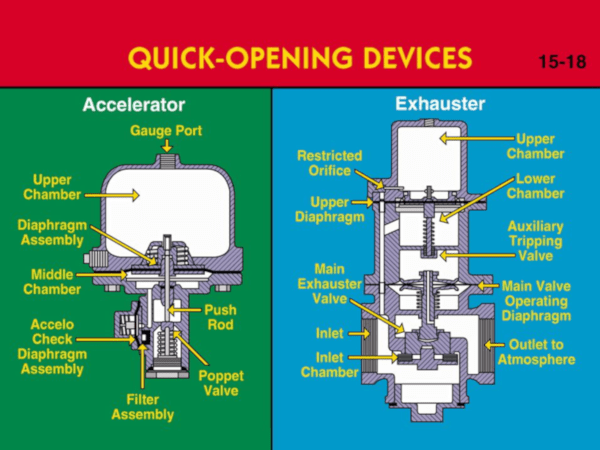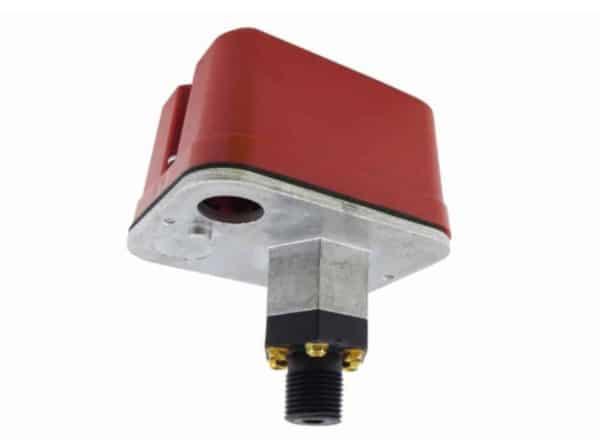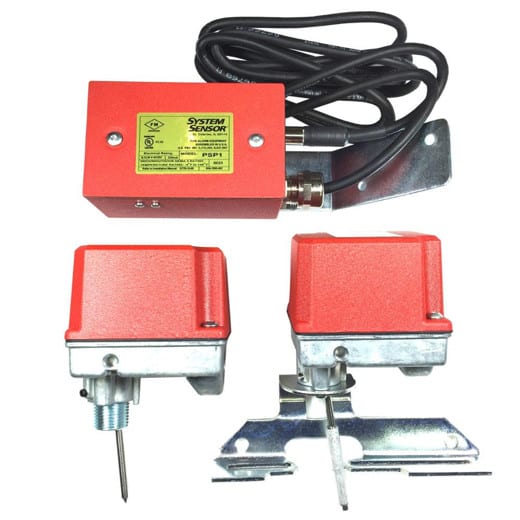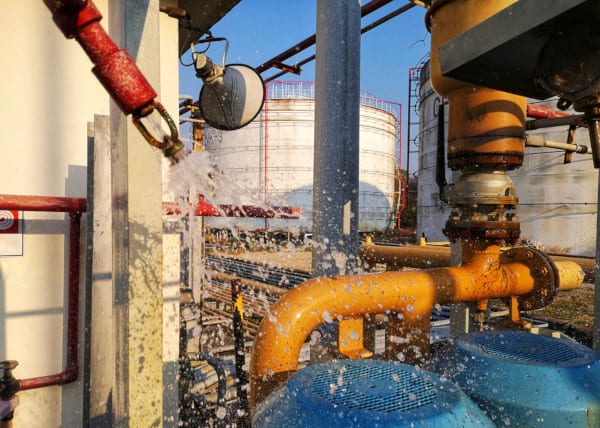Regularly testing dry sprinklers uncovers issues that cause systems to fail
Dry sprinkler systems are specially designed to protect people and property from fires when temperatures drop below freezing. But regular testing is required to deliver true peace of mind that these complex systems won’t fail when they’re needed most. In this installment of our series on dry sprinkler systems, we examine the National Fire Protection Association (NFPA) standards for quarterly and semiannually testing dry sprinklers.
Stay tuned for future blogs covering requirements for tests that must be performed at least once a year, as well as guidelines for maintaining dry systems.
Are you looking to buy components for your building’s sprinkler system? QRFS offers a range of dry sprinkler heads available on special order. Simply give us a call at 888.361.6662 or email support@qrfs.com.
You can also view our in-stock selection of sprinkler gauges, valves, supervisory switches, and other accessories.
Dry sprinklers require extra care to remain in working order
Even the simplest commercial sprinkler system requires a series of tests to keep it in tip-top shape. And with additional, complex parts, a greater potential for corrosion, and regular exposure to freezing temperatures, dry sprinklers need extra TLC to make sure they remain in working order.
Dry sprinkler systems offer reliable automatic fire protection in bitterly cold temperatures by relying on pressurized air or nitrogen to hold back the water supply at a dry pipe valve situated in a heated space. When heat from a fire activates one or more sprinkler heads, the pressure is reduced as the compressed air escapes, opening the valve and enabling the water supply to rush through the pipes and onto the fire. This animation shows how a Viking dry sprinkler system activates:
The 2017 edition of NFPA 25: Standard for the Inspection, Testing, and Maintenance of Water-Based Fire Protection Systems establishes a schedule for testing dry sprinkler systems. These tests require qualified personnel to perform physical checks on all parts of your sprinkler system, generating carefully prepared records for the property owner to store.
Before we begin, this is worth stating again: It’s important to keep in mind that the tests mandated by NFPA 25 and addressed in this blog are routine, and unusual conditions should prompt additional testing. When that occurs, the type of test conducted and the number and location of samples taken should be appropriate to the problem being investigated. Consultations with the manufacturer, listing agency, and authority having jurisdiction (AHJ) can help determine the right course of action.
Quarterly tests of dry sprinkler systems
Priming water level tests
In some dry pipe valve models, a small amount of priming water is used to create a better seal. The priming water level should be tested quarterly to make sure it’s appropriate. The importance of maintaining the proper level can’t be overstated; allowing too much water to build inside the valve can create a water column that stops the dry sprinkler system from operating.
From the 2017 edition of NFPA 25
13.4.5.2.1* The priming water level shall be tested quarterly.
To test priming water levels, open the small priming water level test valve:
- If water flows in a steady stream, it should be drained until air starts to discharge.
- If there is a mix or sputtering of air and water, close the valve because the water level is good.
- If only air escapes, the water level is probably too low, and the valve should be closed immediately. The priming cup can be used to add water according to the manufacturer’s instructions.
Low air pressure alarm tests
Low air pressure alarms prevent accidental trips of dry sprinkler systems by sending an alert before air pressure drops low enough to open the dry pipe valve and flood the system with water. If provided, they are tested as instructed by the manufacturer.
13.4.4.2.13 Low air pressure supervisory devices, if provided on the detection system, shall be tested quarterly in accordance with the manufacturer’s instructions.
Quick-opening device tests
The design of dry sprinkler systems causes a small delay between the time a sprinkler head activates and when water flows onto the fire. Quick-opening devices speed water delivery in dry sprinkler systems to meet NFPA time limits by accelerating the tripping of dry pipe valves. But when they aren’t adequately maintained, false trips can occur—causing too many building owners to solve the problem by turning them off.
This is a dangerous choice because it can cause the system’s water delivery time to extend beyond what’s deemed acceptable by NFPA 13: Standard for the Installation of Sprinkler Systems, enabling fire to grow until it’s beyond the sprinkler system’s ability to control. If the gauge pressure on top of the quick-opening device is zero—or is significantly lower than the air pressure in the system—the quick-opening device may be disabled.

When quick-opening devices are present, they should be tested quarterly. They can almost always be isolated and tested without tripping the dry pipe valve.
13.4.5.2.4* Quick-opening devices, if provided, shall be tested quarterly.
A.13.4.5.2.4 Except when a full flow trip test is conducted in accordance with A.13.4.5.2.2.2, a quick-opening device should be tested in the following manner:
(1) Close the system control valve
(2) Open the main drain valve, and keep it in the open position
(3) Verify that the quick-opening device control valve is open
(4) Open the inspector’s test valve. (Note that a burst of air from the device indicates that it has tripped)
(5) Close the device’s control valve
(6) Return the device to service in accordance with the manufacturer’s instructions and return the system to service. See the NFPA 25 handbook, Water-Based Fire Protection Systems Handbook, for additional guidance relative to potential procedures for the conduct of such testing.
Waterflow device tests
Depending upon what type of alarm equipment is attached to your dry sprinkler system, a mechanical device sounds an alarm or an electrical waterflow switch is tripped when water flows through the dry pipe valve into the sprinkler pipes. NFPA 25 requires quarterly testing of mechanical waterflow devices like water motor gongs, but that timeline stretches to every six months for pressure switch-type waterflow devices.
It’s important to note that the NFPA bans vane-type waterflow devices in dry pipe valves because the force of the water when the valve trips could rip off a vane and force it into the piping.

Waterflow tests are designed to ensure waterflow detecting devices and alarms are operational and signals are sent to and received by the central station, if connected. For that reason, you must always notify the fire department and/or central station before you start a test.
Testing waterflow alarms on dry sprinklers is different than doing it for wet sprinklers because opening the inspector’s test connection will cause the dry pipe valve to trip. Instead, the alarm test line valve is opened to initiate waterflow alarm testing on a dry pipe valve.
The waterflow test line is normally linked to the same line, which drains from the valve’s intermediate chamber to the velocity drip drain. A check valve stops the test water from entering the intermediate chamber, which can trip the dry pipe valve if the velocity drip drain is also clogged. Corrosion tends to accumulate inside the velocity drip drain, preventing it from properly draining.
Before starting a waterflow test, it’s a good idea to exercise the velocity drip valve by pushing the plunger several times to make sure it operates smoothly, nothing is obstructing its path, and the ball isn’t wedged in front of the drain hole.
When testers are ready to begin, they slowly open the alarm test valve while continuously depressing the plunger on the velocity drip. If no water flows from the velocity drip, they continue opening the valve and performing the waterflow test for about 60 seconds or until the alarm sounds. Once the alarm activates, the valve is closed and a call is placed to any central station to confirm the signal was received. Testers should be sure to let them and the fire department know that the test is complete.
If water discharges from the velocity drip when the alarm test valve is opened, close the alarm test valve immediately. This most likely means that the check valve is not doing its job and it’s stopping water from entering the intermediate chamber.
5.3.2 Waterflow Alarm Devices.
5.3.2.1 Mechanical waterflow alarm devices including, but not limited to, water motor gongs, shall be tested quarterly.
5.3.2.2* Vane-type and pressure switch–type waterflow alarm devices shall be tested semiannually.
5.3.2.3.1 Where freezing weather conditions or other circumstances prohibit use of the inspector’s test connection, the bypass connection shall be permitted to be used.
5.3.2.5 Fire pumps shall not be taken out of service during testing unless constantly attended by qualified personnel or all impairment procedures contained in Chapter 15 are followed.
13.2.6.6* Testing waterflow alarm devices on dry pipe, preaction, or deluge systems shall be accomplished by using the bypass connection.
Semiannual tests of dry sprinkler systems
Pressure switch-type waterflow device tests
See the waterflow devices section above; pressure-type switches have testing timelines that expand to twice per year.

Valve supervisory switch tests
Control valves, often generically referred to as butterfly valves (a specific type of valve), control the flow of water in an automatic sprinkler system—and it’s vital that they remain open to allow water to get to sprinkler heads during a fire. Closed control valves are a main reason that sprinkler systems fail. To combat this, NFPA 25 requires valve supervisory switches that indicate unauthorized operation of a control valve to be tested every six months.
Testing should ensure that the supervisory switches send an electronic signal through an alarm system that reports movement from the valve’s normal position, and that the signal is received by the appropriate monitoring station.
From the 2017 edition of NFPA 25
13.3.3.5* Valve Supervisory Switches.
13.3.3.5.1 Valve supervisory switches shall be tested semiannually.
13.3.3.5.2 A distinctive signal shall indicate movement from the valve’s normal position during either the first two revolutions of a hand wheel or when the stem of the valve has moved one-fifth of the distance from its normal position.
13.3.3.5.3 The signal shall not be restored at any valve position except the normal position.
Qualified personnel need to performing dry sprinkler tests
Proper testing of a dry sprinkler system is key to protecting the building and its occupants from fires. When building owners or their representatives choose a company or hire an individual to test the sprinklers, it’s wise to ask for evidence of the qualifications necessary to perform the complex tests required by NFPA 25.
Stay tuned for future blogs covering the requirements for testing that must be performed at least once a year, as well as guidelines for maintaining dry sprinklers.
Are you looking to buy components for your building’s sprinkler system? QRFS offers a range of dry sprinkler heads available on special order. Simply give us a call at 888.361.6662 or email support@qrfs.com.
We also carry sprinkler gauges, valves, supervisory switches, and other accessories and equipment that are online and in-stock.
Check out previous installments in this dry sprinkler system series:
A Guide to Dry Sprinkler Systems, Part 1: System Overview
A Guide to Dry Sprinkler Systems, Part 2: Components and Installation Requirements
A Guide to Dry Sprinkler Systems, Part 5: Daily, Weekly and Monthly Inspections
A Guide to Dry Sprinkler Systems, Part 6: Quarterly, Annual, and Longer Inspections
A Guide to Dry Sprinkler Systems, Part 7: Fighting Corrosion
A Guide to Dry Sprinkler Systems, Part 8: Daily, Weekly, and Monthly Testing


